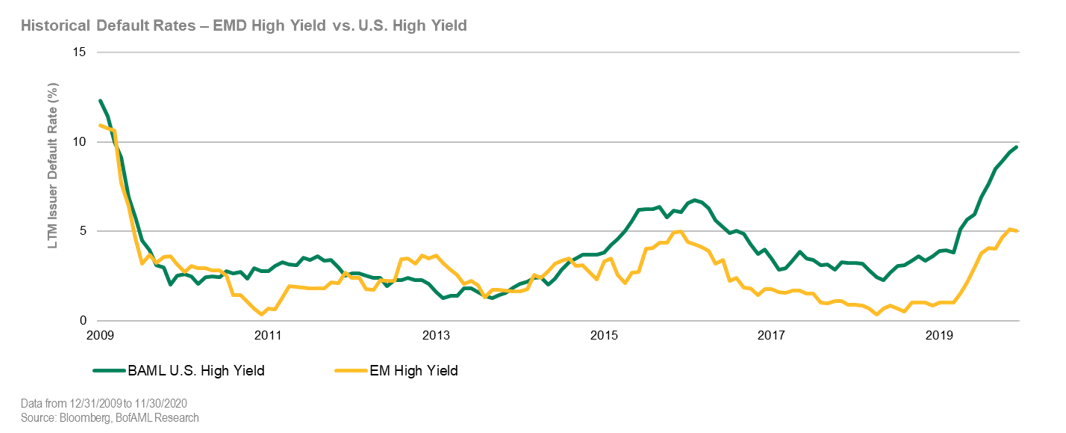Fixed income has roared back to life this year, as interest rate hikes in the U.S. upped yields significantly. Investors have had the opportunity to invest across a wide variety of U.S. fixed income offerings, from Treasuries to high yield. That said, U.S. investors would do well not to miss out on the yields available in emerging markets debt investing. American Century vice president and senior client portfolio manager Joyce Huang shared her thoughts on capturing those premiums this week.
The Emerging Markets Debt Opportunities U.S. Investors Are Overlooking
U.S. investors unfairly apply a risk premium to non-U.S. securities, according to Huang, despite the U.S. facing default risk. That presents an opportunity for those U.S. investors who are open to foreign debt, she explained.
“We find that you can really outperform and find opportunities because a lot of investors don’t look to non-U.S. bonds,” Huang said.
American Century’s fixed income team currently favors U.S. duration, given that the Fed is about done raising rates, Huang said. Europe and the U.K. have some way to go in fighting inflation, with the U.S. expected to go first in cutting rates. Taken together, that creates a “three leg” opportunity set including U.S., developed non-U.S., and emerging markets debt.
“I think that’s going to be a really big opportunity,” Huang said of emerging markets debt investing in particular. “The sentiment around emerging markets has been quite uncertain for 30-plus years.”
The fact that many emerging markets central banks hiked rates before the U.S. did invite a change in that sentiment, she explained. Those firms had to defend their currencies in 2020 during the COVID selloff, leading to attractive yields. Now, EM local bonds are set to benefit from a weakening U.S. dollar and external EM bonds from falling U.S. rates.
The U.S. yield curve is expected to normalize next year, too, Huang said. That’s closing off some of the opportunities in U.S. debt — and opening the door to better opportunities in EM debt.
See more: “American Century’s Venkataraman on Duration, Yield in 2023”
Looking at the Data in Emerging Markets Debt
Part of the concern U.S. investors may have about emerging markets debt surrounds default rates. According to Huang, headline defaults like Argentina’s tend to get a lot of attention. That doesn’t make those defaults sovereign or corporate common, she said.
“When you actually look at EM bonds versus developed market bonds in the same rating bucket, the default rate is actually lower for emerging markets and developed markets,” Huang explained.

Graph courtesy of American Century on U.S. vs EM default rates.
When Argentina defaulted, American Century didn’t hold related bonds because default was obviously coming, Huang added. Active management can also help avoid default risk by empowering managers to avoid that headline risk.
“Active managers who are in the markets can avoid the default stories, and… maximize your yield premium,” she said.
Those managers do that by considering factors like central bank policies and the direction of the U.S. dollar. Central bank decisions have set the stage for a transition to non-U.S. developed and emerging markets debt already. The dollar, too, has a role to play, with its fluctuations tied very closely to the yields available abroad. Perhaps most importantly, advisors also can check countries and corporations’ U.S. dollar balances as a key measure of health for bonds from emerging market issuers denominated in USD.
How to Use ETFs to Play Emerging Markets Debt
American Century offers the American Century Emerging Markets Bond ETF (AEMB) as a key avenue into emerging markets debt investing. The ETF charges a 39 basis point fee to actively invest in investment- and non-investment-grade government and corporate bonds. AEMB heavily leans towards U.S. dollar-denominated debt, which helps provide premiums to its investors.
“I think that this is actually a great way for U.S. investors to start adding emerging market debt to their portfolio allocation. It presents an opportunity for investors lacking experience in emerging markets debt to dip their toe in,” Huang said. “Currencies are the most volatile part of emerging markets. That’s where you can get burned a little bit.”
“When you take the currency piece out, you’re basically just looking at spreads just like dollar-denominated companies,” she added. “It’s really more apples to apples, but you’re getting that risk premium for being in emerging markets.”
What’s more, Huang added, most companies and countries will avoid default on their U.S.-denominated issuance to avoid alienating foreign investors.
AEMB employs a top-down approach, selecting securities based on fundamental research as well as macroeconomic factors and credit analysis. The ETF has returned about 2% over the last six months, according to YCharts. AEMB has also added $7.45 million over the last six months.
Investors can use AEMB as a pure play on emerging markets, or pair it with another ETF. Investors can consider pairing AEMB with the Avantis Core Fixed Income ETF (AVIG), for example. AVIG offers a core focus and is nearing its three-year ETF milestone. While AVIG does have some EM exposures, AEMB adds additional exposures to boost it.
For more news, information, and analysis, visit the Core Strategies Channel.



